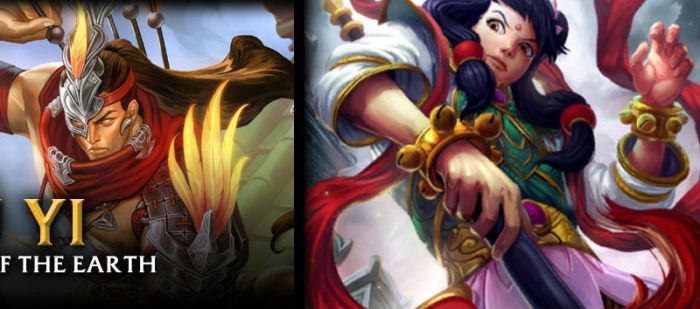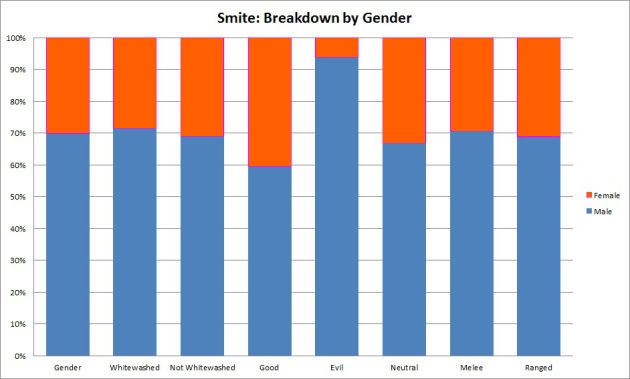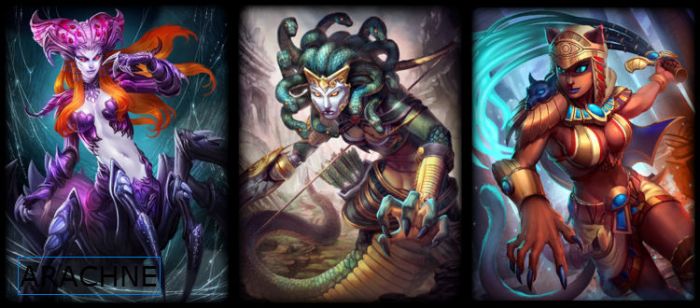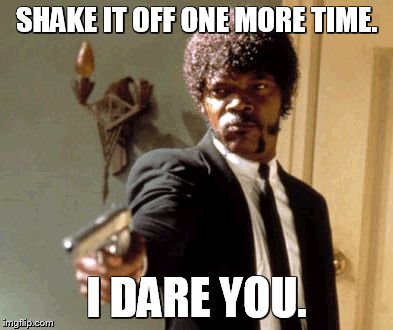[ETA: I’ve revised my comments with regards to the Greek deities and whiteness, which weren’t clear enough, but you should also read the comments.]
I try not to pay attention to MMOs anymore, because the vast majority of them are steaming dung piles of bullshit sexism. However, Smite is a game that kept coming up on my radar for various reasons. When it first came out, my brother emailed me a few pieces of promo art of the female characters. More recently, a few friends over on G+ that have been talking about playing Smite. So when Smite made a few headlines last week for its decision to include Hindu gods as playable characters, I figured that it would be worth taking a closer look since that was the third time in a relatively short period of time that it caught my attention.
As it turns out, I wound up having a lot of stuff to say. So let’s just jump right on in!
Getting ready to rumble
What exactly is Smite? Smite is a MOBA – a Multiplayer Online Battle Arena, a genre made popular by games like Defense of the Ancients 2 (DOTA2) and League of Legends. Smite, like other MOBAs, has a pre-set roster of characters that you can choose to play as that have set abilities. If you wish, you can pay extra to unlock special characters or alternate skins. And Smite has a lot of playable characters – sixty-six in total.
Those of you who have been reading my blog long enough to be familiar with my numbers posts will know that I generally tend to stick to the same set of criteria when evaluating character designs in video games; typically I will compare the numbers of figures that are shown with: 1) active poses versus neutral poses and 2) fully clothed versus suggestively attired by gender in order to demonstrate the consistent under-representation, objectification, and sexualization of female characters.
However, this time around going to all that effort really felt like a tremendous waste of time. Such an approach might be worthwhile when I’m writing about Magic and how, despite recent improvements in art direction, their art is still very sexist. But when I’m looking at a game like Smite, which is just as blatant in it’s bullshit sexism as League of Legends, it just feels like a giant fucking waste of time.
I mean, look. This is Aphrodite:

Ridiculous, right? Even more so when you consider that she’s not even the least clothed Smite character. So let’s just take it as a given that the female character designs are definitely objectifying and sexist and not waste time beating a dead horse[1]. Especially as there were a lot of characters to look at and other issues of representation that I wanted write about regarding problematic racist tropes.
Criteria examined and overall summary
[Note: When looking at characters, I looked at the default designs and descriptions as shown on Gamepedia’s Smite Wiki. If I get anything wrong here, I blame Gamepedia.]
In the end, the criteria I decided to examine were:
Number of figures by gender: simply the number of female figures and the number of male figures
Whether a character was whitewashed: I considered a character to be whitewashed if they came from a nonwhite culture but were explicitly depicted as white. I did not count a character as whitewashed if they were an animal or other nonhuman, had animal features, or had nonhuman skin tones (there are several characters that are either blue or purple). While some of them seemed like edge cases that could count as whitewashing, for the most part it seemed too ambiguous to make a definite argument one way or another.
Deity alignment: This was taken from the character descriptions on the wiki rather than the artwork; each character had a blurb a few paragraphs long about their backstory. I read each and assigned each deity as either Good, Neutral, or Evil. (A lot of the Greek gods wound up as Neutral, just because they capricious assholes even if they are gods of nominally good things.)
Character Damage Type: Again, as defined on the Smite wiki, I was curious to see if there would be an imbalance of Ranged characters versus Melee characters, since that’s a pretty common area of imbalance in many other video games.
After going through all 66 characters and taking tally, here’s what I came up with:
In some ways, the numbers were a bit surprising even while they were also completely predictable. Female characters account for 30% of all playable characters. However, while they were clearly more sexualized and objectified, they weren’t any more likely to be whitewashed or to be pigeon-holed as a ranged character. There is an interesting difference when it comes to alignment, but I’ll come back to that in a bit.
Bullshit sexism
As previously stated, I don’t intend to waste words proving that Smite’s character designs are sexist and bullshit, because they just are. Many of the female promo art pieces feature broken spines, anti-gravity sphere boobs, and painted on clothing. Almost none of the female characters have clothes that would actually function to preserve modesty in any meaningful way in the real world. So regarding the female character design, I’m just going to issue a blanket: THEY’RE BULLSHIT and move on with my life.
Instead, let’s talk about how Smite is another perfect example of the interesting/pretty binary, which I’ve talked about before:
Notice how the male human gets to have actual facial expressions that convey emotions? While the female character renders all have the same vapid expression but with different hairstyles. Because men get to DO THINGS and EXPRESS THEMSELVES but women get to BE PRETTY.
When looking at the different character types, there is such a huge variety when it comes to male characters! Male deities can be humans, humanoids, demi-humans, robots, giant flying serpents, or even giant-ass rock-creatures. Whereas the female deities? Well they get boobs. And sometimes funny hats.
Case in point, look at what happens when you compare male animal and demi-human deities with female animal and demi-human deities:
(TOP LEFT: Anhur, TOP MIDDLE: Anubis, TOP RIGHT: Fenrir, BOTTOM LEFT: Arachne, BOTTOM MIDDLE: Medusa, BOTTOM RIGHT: Bastet)
The male deities are all very appealing avatar images. They give a strong sense of the culture that they come from, while also appearing strong and heroic. Whereas the female deities? The most important part of their designs are their tits, and making sure that they are clearly visible to the viewer. Giant spider thing? TITS. Man-eating snake thing? ‘DEM BOOBS THO. It really goes a long way toward illustrating[2] the priorities of the design team.
Now the interesting thing about Smite is that is that it also manages to throw in some “benevolent” sexism along with all of the bullshit objectification. Remember how I said there was a weird gender imbalance when it came to deity alignment? Well it turns out that out of 19 evil deities, only one is female:


Now, you may be saying to yourself – but wundergeek, I don’t get it. What’s the problem? The problem is that the stereotype of women are more wholesome and more nurturing is benevolent sexism, which is still sexism. It’s like the boss I had once who told me he only hired women to work in the office because we were more nurturing and community-minded. I found his comment terribly offensive, but didn’t say anything because I happened to desperately need the job at the time.
However, even if it is a stereotype I will admit that this actually ran counter to what I expected. Given that the female characters in Smite were so grossly oversexualized, I had expected the evil deities to skew female – you know, because sexy women are always evil. Since, you know, [mumblemumble]femme fatale[mumblereasons].
So at least if the female characters are horribly stereotyped, at least we have a mix of regressive stereotypes. Yay diversity!
Racist whitewashing
Something that’s honestly more important than the frankly not-all-that-exceptional-for-video-games level of sexism in Smite is the fact that there is an UNBELIEVABLE LEVEL OF WHITEWASHING. Literally EVERY PANTHEON except the Norse deities is whitewashed, with the worst example being the Greek pantheon – who are shown almost universally as blondes or gingers:

[sigh] Uh, video game industry dudes? I’m not sure if you’ve noticed, but Greeks are NOT ACTUALLY WHITE ACTUALLY PRETTY BROWN. Take for example, Tonia Sotiropoulou – who played the Bond Girl[3] in Skyfall. I realize this is an embarrassingly common trope in video games (I’m looking at you Soul Calibur!) but this is pretty fucking awful.
However, EVEN WORSE than the Greek deities are the Chinese deities:

WHY DO NONE OF THEM LOOK ASIAN? Seriously, the only one who maybe looks even sorta-kinda Asian is Chang’e, and even then she still looks Katy Perry doing her best Asian drag. All of them have round eyes and decidedly European features.
And I already know what some people might be saying; OMG it’s just the style, the art is anime-influenced, the art is heavily stylized, blah blah blah. So let’s take a second and zoom in on two of the character portraits for these supposedly Chinese deities, shall we?

Looking closely at the faces, you can see that it’s not just the eyes – although those are a big part of why they look decidedly un-Chinese. Their eyes are round, with visible lids, and are un-slanted. But more than that, the features and facial structure overall conveys the impression of whiteness. And given that I see this mistake repeated again and again across all of the character designs, I have to think that this mistake is more than just accidental.
The Chinese deities do not look Chinese. The Greek deities do not look Greek. The Hindu deities do not look South Asian. It’s obvious that effort was put into ensuring that the costume design would be recognizably adherent to the culture that was being referenced, but when it came to the actual faces of the gods being portrayed? The artist doing the designs obviously didn’t bother looking up references for non-white faces, because EVERY. SINGLE. DEITY. has white features. ALL of the deities that are even slightly human have indisputably white features, which is frankly, inexcusable.
About the only positive thing that can be said with regard to Smite’s frankly terribly racist character designs is that, contrary to my first impression, heroic gods weren’t more likely to be whitewashed than evil ones. So. yay? At least we’re engaging in equal opportunity racism and whitewashing here.
Culturally Appropriating
And here we come to the bit that inspired me to write about Smite in the first place. Apparently the publishers of Smite have decided to add Hindu deities as a faction – a decision which breaks with their use of only dead religions for all of their other factions. (ETA: It’s been pointed out to me that Norse paganism is not actually a dead religion, even if it is widely perceived to be. I apologize.) Unsurprisingly, given that Hinduism is a religion that is alive and well in the world today, there was pushback against this decision, arguing that if Hinduism was fair game that figures from other modern religion – like Jesus or Moses should be permissible.
However, Smite’s publishers would like us all to know that they are definitely not going to use Christian, Jewish, or Islamic figures in their game. But don’t worry – Hindu deities are still a-okay!

…which is, frankly, pretty bullshit. Especially when you look at the list of Hindu deities that are included, like Rama – one of the chief avatars of Vishnu and one of the most widely venerated figures in Hinduism today. And Hinduism is not a small religion! With approximately 1 billion adherents, Hindus account for approximately 1 in 7 humans on the planet – which makes the decision of Smite developers to use religious figures of central importance to a large and vibrant modern religion all the more shocking.
Because it’s obvious that when faced with the question of “where to draw the line” that the developers of Smite were clear on the fact that they weren’t willing to do anything that might offend any adherents of the Abrahamic traditions, many of whom are white or can pass for white[4]. But Hinduism? Well Hinduism is for INDIANS who are just so, you know, EXOTIC.
…which is just more creepy, culturally appropriating bullshit.
But really, given how generally awful Smite is, I guess that shouldn’t be too surprising.
 [1] Fair warning. Any comments attempting to argue that Smite’s character designs aren’t sexist are going to be straight-up trashed. I don’t have time for bullshit of that magnitude.
[1] Fair warning. Any comments attempting to argue that Smite’s character designs aren’t sexist are going to be straight-up trashed. I don’t have time for bullshit of that magnitude.
[2] See what I did there?
[3] I have a whole ‘nother rant about Bond Girls and how fucking sexist they are, and how it’s particularly awful that in Skyfall the Bond Girl literally has sex with Bond and then has maybe 3 or 4 more lines of dialogue before dying.
[4] I realize that I am arguing something problematic here. There is a perception that Christianity is equated with whiteness, despite the fact that there are large and vibrant faith communities in South America and Africa and other areas of the world that are decidedly nonwhite. And given the overlap of traditions between the Abrahamic faiths, there tends to be a certain level of automatic goodwill extended to Judaism and Islam. However, I recognize the racial diversity of the communities that practice these faiths and certainly am not arguing that they are worth protecting because of their whiteness or proximity to whiteness.






